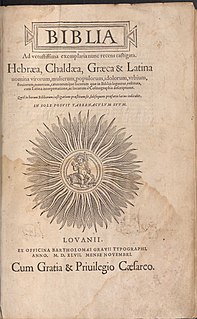 W
WThe 36-line Bible, also known as the "Bamberg Bible", was the second moveable-type-printed edition of the Bible. It is believed to have been printed in Bamberg, Germany, circa 1458–1460. No printer's name appears in the book, but it is possible that Johannes Gutenberg was the printer.
 W
WThe Benedictine Vulgate is a critical edition of the Vulgate version of the Old Testament, Catholic deuterocanonicals included, mainly done by the Benedictine monks of the pontifical Abbey of St Jerome-in-the-City and published progressively from 1926 to 1995 in 18 volumes.
 W
WThe Gutenberg Bible was among the earliest major books printed using mass-produced movable metal type in Europe. It marked the start of the "Gutenberg Revolution" and the age of printed books in the West. The book is valued and revered for its high aesthetic and artistic qualities as well as its historic significance. It is an edition of the Latin Vulgate printed in the 1450s by Johannes Gutenberg in Mainz, in present-day Germany. Forty-nine copies have survived. They are thought to be among the world's most valuable books, although no complete copy has been sold since 1978. In March 1455, the future Pope Pius II wrote that he had seen pages from the Gutenberg Bible displayed in Frankfurt to promote the edition. It is not known how many copies were printed; the 1455 letter cites sources for both 158 and 180 copies. The 36-line Bible, said to be the second printed Bible, is also referred to sometimes as a Gutenberg Bible, but may be the work of another printer.
 W
WThe Leuven Vulgate or Hentenian Bible is an edition of the Vulgate which was edited by Hentenius (1499–1566) and published in Louvain in 1547. This edition was republished several times, and in 1574 a revised edition was published.
 W
WThe Nova Vulgata, also called the Neo-Vulgate, the New Latin Vulgate or the New Vulgate, is the official Classical Latin translation of the original-language texts of the Bible from modern critical editions published by the Holy See for use in the contemporary Roman rite. It was completed in 1979, and was promulgated the same year by John Paul II in Scripturarum thesaurus. A second, revised, edition was promulgated in 1986, again by John Paul II. It is the official Latin text of the Catholic Church.
 W
WThe Oxford Vulgate is a critical edition of the Vulgate version of the New Testament produced by scholars of the University of Oxford, and published progressively between 1889 and 1954 in 3 volumes.
 W
WThe Sixtine Vulgate or Sistine Vulgate is the edition of the Vulgate—a 4th-century Latin translation of the Bible that was written largely by Jerome—which was published in 1590, prepared by a commission on the orders of Pope Sixtus V and edited by himself. It was the first edition of the Vulgate authorised by a pope. Its official recognition was short-lived; the edition was replaced in 1592 by the Sixto-Clementine Vulgate.
 W
WThe Sixto-Clementine Vulgate or Clementine Vulgate is the edition promulgated in 1592 by Pope Clement VIII of the Vulgate—a 4th-century Latin translation of the Bible that was written largely by Jerome. It was the second edition of the Vulgate to be authorised by the Catholic Church, the first being the Sixtine Vulgate. The Sixto-Clementine Vulgate was used officially in the Catholic Church until 1979, when the Nova Vulgata was promulgated by Pope John Paul II.
 W
WThe Stuttgart Vulgate or Weber-Gryson Vulgate is a manual critical edition of the Vulgate first published in 1969.